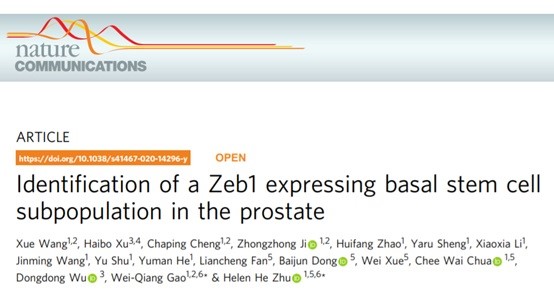


He Zhu, Weiqiang Gao from Renji-Med-X Stem Cell Research Center, Published a Nature Communications Paper: Discovery of Prostate Basal Stem Cells with Epithelial and Mesenchymal Expression Profiles
February 09, 2020
Statistics in the United States shows that prostate cancer ranks 1st in males’ cancer incidence rate and 2nd in mortality, all of which are still increasing year by year among Chinese for a more and more western-styled diet and living habits. It is of great importance to clarify the cellular origin of prostate cancer. Regarding many similarities between normal organs and tumor development, the study of the former, prostate, helps us better understand the latter.
Experiments on rodent animals indicate that after androgen deprivation, prostate epithelial tissue takes on collapsed lumen due to serious apoptosis of epithelial cells. Cells and tissues will proliferate and regenerate when the androgen level returns back to normal. This process can be repeated up to 30 times, which suggests prostate epithelial tissue has stem cells, making it a good model for stem cell biology. The prostate basal cell compartment in many epithelial tissues is suggested to contain stem cells, but the stem cell subpopulation within prostate basal cells and its transcriptional profile remain largely unknown.
Researcher He Zhu, Professor Weiqiang Gao from Renji-Med-X Stem Cell Research Center, published their findings in Nature Communications (IF = 11.9) online: Identification of a Zeb1 expressing basal stem cell subpopulation in the prostate on February 5th, 2020. The paper revealed the heterogeneity of PBSCs and identified a subpopulation that expressed epithelial and mesenchymal profiles as well as high epithelial-to-mesenchymal transition, (EMT), while at the same time, reported the significance of Zeb1, an EMT induer, as an essential regulator in PBSC development.

The study presented a Zeb1-positive cell subpopulation in PBSC layer using fluorescent reporter mice and lineage tracing analysis and demonstrates that Zeb1 positive basal cells can self-renew, give rise to tubular-shaped prostate tissue, and have multilineage differentiation ability to become basal, luminal and neuroendocrine cell lineages. Gene knockout test showed that Zeb1 was involved in PBSC development. Furthermore, through high-throughput single-cell sequencing technology, Zeb1 positive basal epithelial cell subpopulations showed the molecular expression profiles of epithelial, mesenchymal and epithelial-mesenchymal transition. At the same time, these cells were positively regulated by Wnt signaling pathway. Furthermore, Zeb1 positive epithelial cells were detected in mice and clinical prostate tumor samples (luminal epithelial cell phenotype). The study also found Zeb1 positive luminal epithelial cells were likely to be tumor derived cells, which promote oncogenesis and tumor progression.
This study provided sufficient evidence for the close relation between Zeb1 positive basal stem cell subpopulation and clinical prostate tumor oncogenesis and progression, meanwhile served as a solid theoretical basis for clinical diagnosis.
The study’s first author, Xue Wang, is a doctoral student in the school of Biomedical Engineering in Shanghai Jiaotong University.
Full text link: